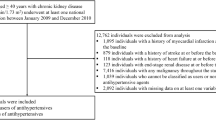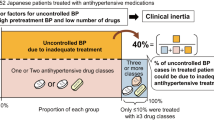Abstract
Hypertension is the most common complication of kidney disease, diabetes, and other cardiovascular diseases. In addition, it is a critical factor in the progression of these diseases, and hence, blood pressure management is highly recommended worldwide, in accordance with the major guidelines. However, there are two blind spots in the management system: one concerns patients with cancer, and the other concerns patients receiving renal replacement therapy. End-stage renal failure is the final stage of hypertension, and nephrologists usually treat hypertension in both nondialysis patients and dialysis patients. Nephrologists first attempt to manage the blood pressure of dialysis patients using the same method employed for nondialysis patients, i.e., by deciding on a target blood pressure at the clinic. However, this is exceedingly difficult because dialysis patients have lost their most important body-fluid autoregulatory mechanism and have varying body weights during the dialysis session. Moreover, numerous lines of evidence and clinicians’ observations have suggested that hypotension during a dialysis session leads to an unfavorable prognosis. However, when the target blood pressure is increased to avoid hypotension during a dialysis session, the risk of atherosclerosis and bleeding complications will be increased. Many nephrologists may feel unsure of choosing a target blood pressure using traditional methods. Recently, home blood pressure and average blood pressure have become new indices of blood pressure management. We believe that further advancements of this old and important theme will be possible with new technologies and big-data analytical methods.
This is a preview of subscription content, access via your institution
Access options
Subscribe to this journal
Receive 12 print issues and online access
$259.00 per year
only $21.58 per issue
Buy this article
- Purchase on Springer Link
- Instant access to full article PDF
Prices may be subject to local taxes which are calculated during checkout

Similar content being viewed by others
References
Nitta K, Masakane I, Hanafusa N, Taniguchi M, Hasegawa T, Nakai S, et al. Annual dialysis data report 2017, JSDT Renal Data Registry. Ren Replacement Ther. 2019;5:53.
Hirakata H, Nitta K, Inaba M, Shoji T, Fujii H, Kobayashi S, et al. Japanese Society for Dialysis Therapy Guidelines for Management of Cardiovascular Diseases in Patients on Chronic Hemodialysis. Ther Apheresis Dial. 2012;16:387–435.
James PA, Oparil S, Carter BL, Cushman WC, Dennison-Himmelfarb C, Handler J, et al. 2014 Evidence-Based Guideline for the Management of High Blood Pressure in Adults: report From the Panel Members Appointed to the Eighth Joint National Committee (JNC 8)2014 Guideline for Management of High Blood Pressure2014 Guideline for Management of High Blood Pressure. JAMA. 2014;311:507–20.
Whelton PK, Carey RM, Aronow WS, Casey DE Jr, Collins KJ, Dennison Himmelfarb C, et al. 2017 ACC/AHA/AAPA/ABC/ACPM/AGS/APhA/ASH/ASPC/NMA/PCNA Guideline for the Prevention, Detection, Evaluation, and Management of High Blood Pressure in Adults: Executive Summary: A Report of the American College of Cardiology/American Heart Association Task Force on Clinical Practice Guidelines. Hypertension. 2018;71:1269–324.
Shimamoto K, Ando K, Fujita T, Hasebe N, Higaki J, Horiuchi M, et al. The Japanese Society of Hypertension Guidelines for the Management of Hypertension (JSH 2014). Hypertens Res. 2014;37:253.
Umemura S, Arima H, Arima S, Asayama K, Dohi Y, Hirooka Y, et al. The Japanese Society of Hypertension Guidelines for the Management of Hypertension (JSH 2019). Hypertension Res. 2019;42:1235–481.
Moriya H, Ohtake T, Kobayashi S. Aortic stiffness, left ventricular hypertrophy and weekly averaged blood pressure (WAB) in patients on haemodialysis. Nephrol Dial Transpl. 2007;22:1198–204.
Moriya H, Oka M, Maesato K, Mano T, Ikee R, Ohtake T, et al. Weekly averaged blood pressure is more important than a single-point blood pressure measurement in the risk stratification of dialysis patients. Clin J Am Soc Nephrol. 2008;3:416–22.
Sarafidis PA, Persu A, Agarwal R, Burnier M, de Leeuw P, Ferro CJ, et al. Hypertension in dialysis patients: a consensus document by the European Renal and Cardiovascular Medicine (EURECA-m) working group of the European Renal Association-European Dialysis and Transplant Association (ERA-EDTA) and the Hypertension and the Kidney working group of the European Society of Hypertension (ESH). Nephrol Dial Transpl. 2017;32:620–40.
Inaba M, Karaboyas A, Akiba T, Akizawa T, Saito A, Fukuhara S, et al. Association of blood pressure with all-cause mortality and stroke in Japanese hemodialysis patients: the Japan Dialysis Outcomes and Practice Pattern Study. Hemodial Int. 2014;18:607–15.
Bansal N, McCulloch CE, Lin F, Alper A, Anderson AH, Cuevas M, et al. Blood Pressure and Risk of Cardiovascular Events in Patients on Chronic Hemodialysis: The CRIC Study (Chronic Renal Insufficiency Cohort). Hypertension. 2017;70:435–43.
Hannedouche T, Roth H, Krummel T, London GM, Jean G, Bouchet JL, et al. Multiphasic effects of blood pressure on survival in hemodialysis patients. Kidney Int. 2016;90:674–84.
Shoji T, Tsubakihara Y, Fujii M, Imai E. Hemodialysis-associated hypotension as an independent risk factor for two-year mortality in hemodialysis patients. Kidney Int. 2004;66:1212–20.
Chou JA, Streja E, Nguyen DV, Rhee CM, Obi Y, Inrig JK, et al. Intradialytic hypotension, blood pressure changes and mortality risk in incident hemodialysis patients. Nephrol Dial Transplant. 2018;33:149–59.
Huang WH, Hsu CW, Hu CC, Yen TH, Weng CH. Predialysis hypotension is not a predictor for mortality in long-term hemodialysis patients: insight from a single-center observational study. Ther Clin Risk Manag. 2016;12:1285–92.
Sands JJ, Usvyat LA, Sullivan T, Segal JH, Zabetakis P, Kotanko P, et al. Intradialytic hypotension: frequency, sources of variation and correlation with clinical outcome. Hemodial Int. 2014;18:415–22.
Yotsueda R, Taniguchi M, Tanaka S, Eriguchi M, Fujisaki K, Torisu K, et al. Cardiothoracic Ratio and All-Cause Mortality and Cardiovascular Disease Events in Hemodialysis Patients: the Q-Cohort Study. Am J Kidney Dis. 2017;70:84–92.
Zoccali C, Moissl U, Chazot C, Mallamaci F, Tripepi G, Arkossy O, et al. Chronic Fluid Overload and Mortality in ESRD. J Am Soc Nephrol. 2017;28:2491–7.
Shoji T, Masakane I, Watanabe Y, Iseki K, Tsubakihara Y. Elevated non-high-density lipoprotein cholesterol (non-HDL-C) predicts atherosclerotic cardiovascular events in hemodialysis patients. Clin J Am Soc Nephrol. 2011;6:1112–20.
Japanese Society for Dialysis Therapy. Dialysis prescription and patient survival [in Japanese]. in Illustrated version of an overview of regular dialysis treatment in Japan (as of 31 December 2009). Japanese Society for Dialysis Therapy: Tokyo; 2010. p. 66–89.
Agarwal R, Alborzi P, Satyan S, Light RP. Dry-weight reduction in hypertensive hemodialysis patients (DRIP): a randomized, controlled trial. Hypertension. 2009;53:500–7.
Agarwal R, Sinha AD, Pappas MK, Abraham TN, Tegegne GG. Hypertension in hemodialysis patients treated with atenolol or lisinopril: a randomized controlled trial. Nephrol Dial Transpl. 2014;29:672–81.
Fravel MA, Bald E, Fraer M. Antihypertensive Agents in the Dialysis Patient. Curr Hypertens Rep. 2019;21:5.
Working Group Committee for the Preparation of Guidelines for Peritoneal Dialysis JSfDT. 2009 Japanese Society for Dialysis Therapy Guidelines for Peritoneal Dialysis. Ther Apheresis Dial. 2010;14:489–504.
Afshinnia F, Zaky ZS, Metireddy M, Segal JH. Reverse Epidemiology of Blood Pressure in Peritoneal Dialysis Associated with Dynamic Deterioration of Left Ventricular Function. Perit Dial Int. 2016;36:154–62.
Udayaraj UP, Steenkamp R, Caskey FJ, Rogers C, Nitsch D, Ansell D, et al. Blood pressure and mortality risk on peritoneal dialysis. Am J Kidney Dis. 2009;53:70–8.
Cosio FG, Pelletier RP, Pesavento TE, Henry ML, Ferguson RM, Mitchell L, et al. Elevated blood pressure predicts the risk of acute rejection in renal allograft recipients. Kidney Int. 2001;59:1158–64.
Taler SJ, Textor SC, Canzanello VJ, Schwartz L. Cyclosporin-induced hypertension: incidence, pathogenesis and management. Drug Saf. 1999;20:437–49.
Okada H, Yasuda Y, Kashihara N, Asahi K, Ito T, Kaname S, et al. Essential points from Evidence-based Clinical Practice Guidelines for Chronic Kidney Disease 2018. Clin Exp Nephrol. 2019;23:1–15.
Hillebrand U, Suwelack BM, Loley K, Lang D, Reuter S, Amler S, et al. Blood pressure, antihypertensive treatment, and graft survival in kidney transplant patients. Transpl Int. 2009;22:1073–80.
Opelz G, Dohler B. Improved long-term outcomes after renal transplantation associated with blood pressure control. Am J Transpl. 2005;5:2725–31.
Author information
Authors and Affiliations
Corresponding author
Ethics declarations
Conflict of interest
The author received honoraria and/or fees for the promotional materials from KyowaKirin, Chugai Pharmaceutical, Kissei Pharmaceutical, and Fuji Yakuhin and received research funding from KyowaKirin and Chugai Pharmaceutical.
Additional information
Publisher’s note Springer Nature remains neutral with regard to jurisdictional claims in published maps and institutional affiliations.
Rights and permissions
About this article
Cite this article
Kanno, Y. Blood pressure management in patients receiving renal replacement therapy. Hypertens Res 44, 7–12 (2021). https://doi.org/10.1038/s41440-020-00563-4
Received:
Revised:
Accepted:
Published:
Issue Date:
DOI: https://doi.org/10.1038/s41440-020-00563-4
Keywords
This article is cited by
-
Seasonal variation and predictors of intradialytic blood pressure decline: a retrospective cohort study
Hypertension Research (2021)
-
Seasonal variation and predictors of intradialytic hypotension
Hypertension Research (2021)



